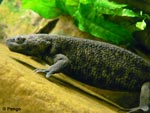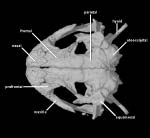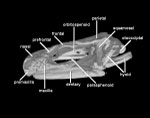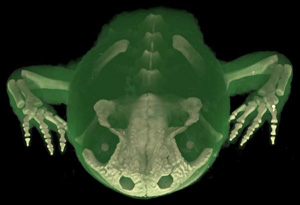The Spanish ribbed newt (Pleurodeles waltl) is  distributed throughout Portugal, central and southern Spain, and Morocco. This is a relatively large species of salamander and can reach up to 30 cm in length. Skin coloration is variable and includes olive-green, brown, and yellow. The underside can be light yellow, grey, or white. A series of warts extend up both side of the body covering protruding ribs, which offer protection against predators (Griffiths, 1996). Spanish ribbed newts belong to the group Salamandridae. Salamandridae includes 15 genera and 55 species of salamanders and newts. Species are distributed throughout North America, Europe, northwest Africa, and Asia. Some species are terrestrial but most are either mostly or fully aquatic (Pough et al., 1998).
distributed throughout Portugal, central and southern Spain, and Morocco. This is a relatively large species of salamander and can reach up to 30 cm in length. Skin coloration is variable and includes olive-green, brown, and yellow. The underside can be light yellow, grey, or white. A series of warts extend up both side of the body covering protruding ribs, which offer protection against predators (Griffiths, 1996). Spanish ribbed newts belong to the group Salamandridae. Salamandridae includes 15 genera and 55 species of salamanders and newts. Species are distributed throughout North America, Europe, northwest Africa, and Asia. Some species are terrestrial but most are either mostly or fully aquatic (Pough et al., 1998).
Spanish ribbed newts are aquatic and prefer ponds, lakes, and streams with a substantial amount of vegetation. During periods of drought, individuals will burrow underground until water is restored in their habitat. The species is nocturnal and bottom-dwelling. The diet of Spanish ribbed newts includes almost any prey that is small enough to swallow, which can include other amphibians (Griffiths, 1996).
Mating occurs between March and June, although this season can be extended during warm winters. Fertilization is internal with males depositing a spermatophore inside the cloaca of the female. Clutch size ranges from 200 to 300 eggs, which are laid on plants or stones. Females can either lay each egg individually or in small clusters. Once larvae hatch they grow to about 10 cm before metamorphosis (Griffiths, 1996).
Additional Information on the Skull
Click on the thumbnails below for labeled images of the skull in standard anatomical views.

Literature
Griffiths, R. A. 1996. Newts and Salamanders of Europe. Academic Press Limited, San Diego, CA. 188 pp.
Pough, F. H., R. M. Andrews, J. E. Cadle, M. L. Crump, A. H. Savitzky, K. D. Wells. 1998. Herptetology. Prentice Hall, Inc., Upper Saddle River, NJ. 577 pp.
Links
Pleurodeles waltl page on Caudata Culture
Pleurodeles waltl page on Livingunderworld.org













